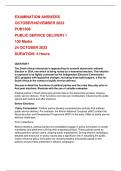EXAMINATION ANSWERS
OCTOBER/NOVEMBER 2023
PUB1508
PUBLIC SERVICE DELIVERY I
100 Marks
24 OCTOBER 2023
DURATION: 4 Hours
QUESTION 1
The South African electorate is approaching its seventh democratic national
Election in 2024, one which is being touted as a watershed election. This election
Is expected to be tightly contested as the Independent Electoral Commission
(IEC) grapples with legislative changes, including three ballot papers, a first for
South Africa.In the context of public service delivery:
Discuss in detail the functions of political parties and the roles they play prior to
And post elections. Illustrate with the use of suitable examples.
Political parties in South Africa play pivotal roles in the democratic process, shaping
public service delivery. Their functions and roles are multifaceted, influencing the public
sphere both before and after elections.
Before Elections:
Policy Formulation: Political parties develop comprehensive policies that address
public service delivery. For example, the African National Congress (ANC) crafted the
Reconstruction and Development Programme (RDP) in the early 1990s to tackle service
delivery challenges.
Prior to Elections:
Before elections, political parties and candidates engage in policy formulation to create
manifestos and platforms outlining their proposed policies. These policies serve as
selling points to attract voters, shaping public expectations. During election campaigns,
debates and discourse on policy issues play a significant role in educating the public.
Voters influence policy formulation by choosing leaders and parties based on the
policies and promises presented in election campaigns.
, Post Elections:
After elections, the winning party's election promises and policy positions serve as a
blueprint for governance. Elected officials work to translate campaign promises into
actionable policies, including laws and programs. The election results provide a
mandate for the government's policy direction, reflecting the will of the majority. Checks
and balances, provided by opposition parties and democratic institutions, ensure that
policies adhere to legal and ethical standards and meet the needs of the diverse
citizenry. Post-election, there is an ongoing process of policy evaluation and adjustment
based on factors like economic conditions and public opinion.
Election Manifestos: Parties create detailed election manifestos outlining their vision
for improving public services. These manifestos often contain specific commitments to
healthcare, education, and infrastructure development.
Prior to Elections:
Election manifestos, prior to elections, are pivotal in setting the agenda, informing
voters, and guiding campaign strategies. They serve as a roadmap for political parties
and candidates, outlining their policy proposals and priorities. Manifestos inform the
electorate, helping voters make informed choices. They also shape campaign strategies
by providing a clear set of promises to appeal to specific voter demographics and
differentiate from opponents, fostering transparency and trust in the democratic
process.
Post Elections:
After elections, manifestos are crucial for policy implementation, offering a blueprint for
transforming campaign promises into concrete policies and programs. They reflect the
party's or candidate's platform, legitimizing their policy direction based on the mandate
received from the majority of voters. Manifestos also enable monitoring and evaluation
by the public and opposition parties, encouraging accountability. Over time,
governments can adapt their manifesto-based policies to changing circumstances and
new challenges, making manifestos dynamic documents that respond to evolving
priorities and public needs.
Mobilizing Support: Parties embark on extensive election campaigns, rallying their
supporters. They employ various strategies, from mass rallies to door-to-door
canvassing. These campaigns emphasize their role in enhancing public service quality.
Prior to Elections:
Mobilizing support prior to elections is a multifaceted process that involves building
broad coalitions of backers, fundraising efforts, extensive campaigning, and persuasive




